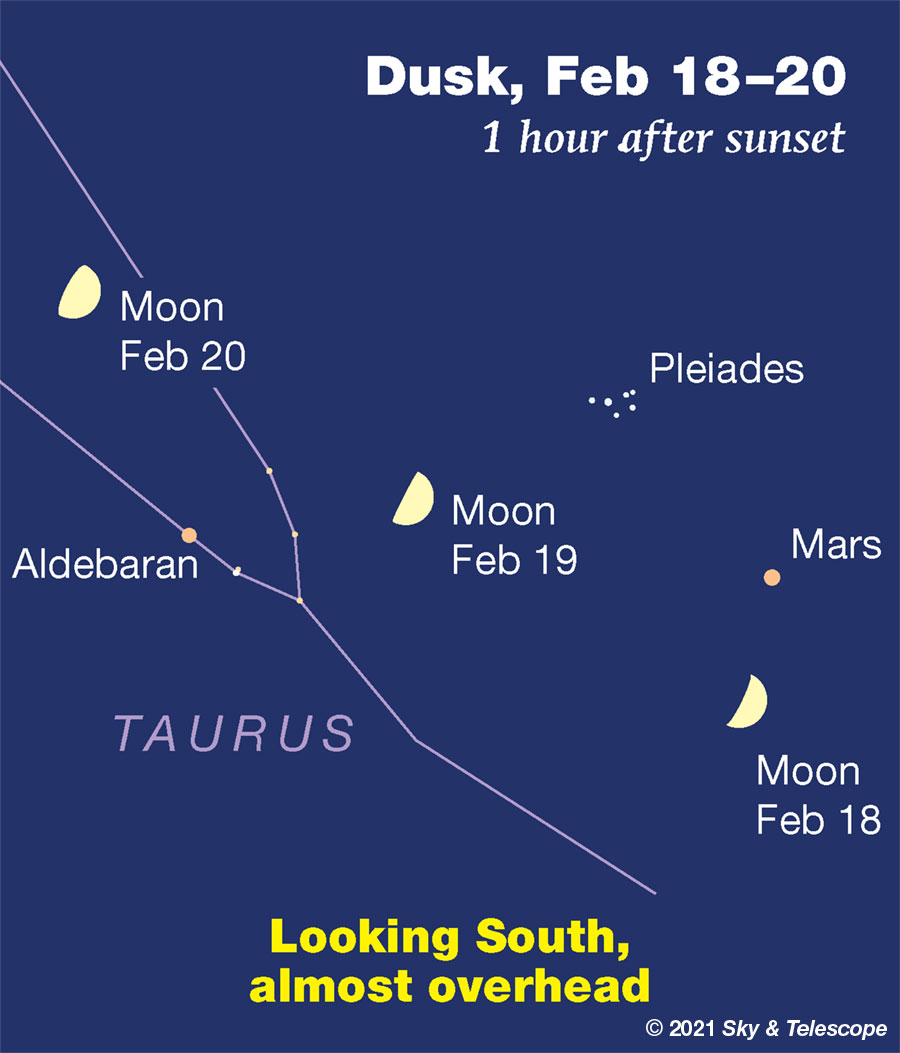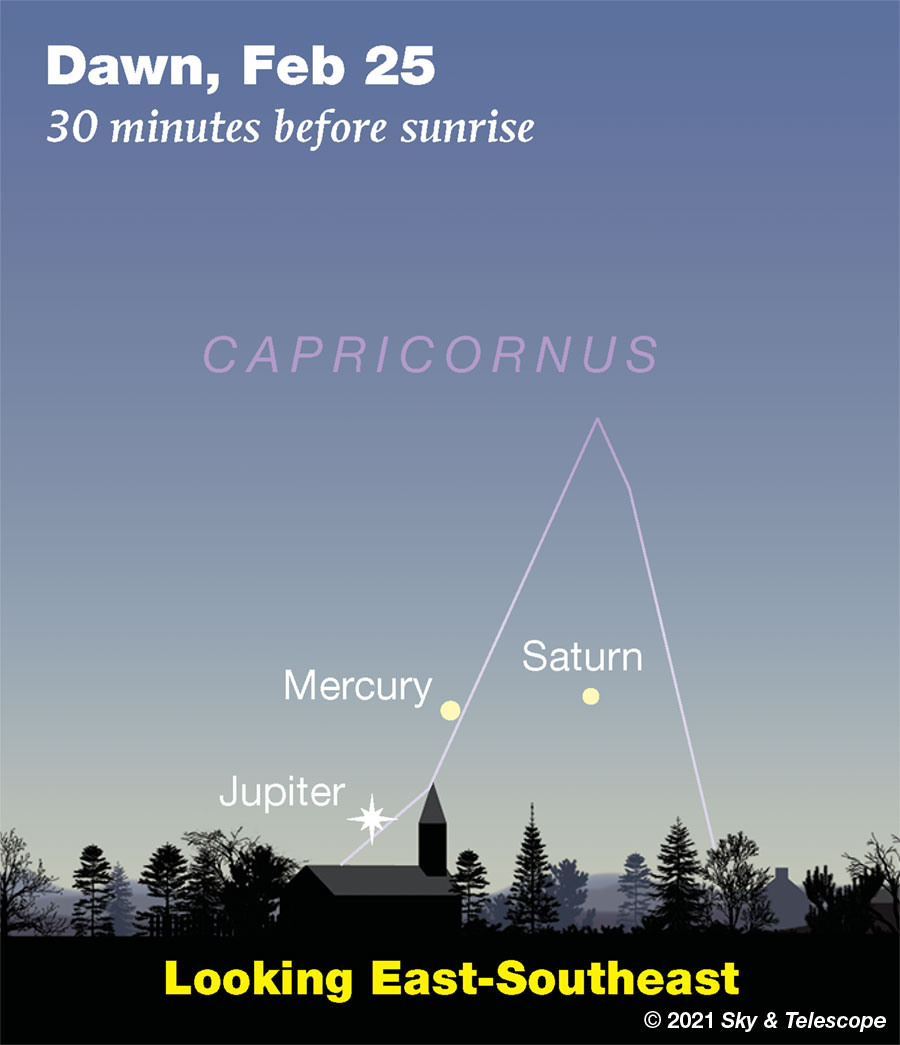FRIDAY, FEBRUARY 19
■ First-quarter Moon (exactly so at 1:47 p.m. EST). The Moon shines between Aldebaran and the Pleiades high this evening, as shown below. Every February, the first-quarter Moon is in their vicinity.

Nowhere in human experience but astronomy are things so different than they look.
SATURDAY, FEBRUARY 20
■ Now spot Aldebaran below the Moon, as shown above.
■ After dinnertime at this time of year, five carnivore constellations are rising upright in a row from the northeast to south. They're all seen in profile with their noses pointed up and their feet (if any) to the right. These are Ursa Major the Big Bear in the northeast (with the Big Dipper as its brightest part), Leo the Lion in the east, Hydra the Sea Serpent in the southeast, Canis Minor the Little Dog higher in the south-southeast, and bright Canis Major the Big Dog in the south.
SUNDAY, FEBRUARY 21
■ The Moon in early evening shines between Orion below it and Auriga above it at the zenith, and between Taurus to its right and Gemini to its left. In fact, the Moon shines close to the meeting places of the official borders of those four constellations (during evening for North America).
MONDAY, FEBRUARY 22
■ Have you ever seen Canopus, the second-brightest star after Sirius? In one of the interesting coincidences known to devoted skywatchers, Canopus lies almost due south of Sirius: by 36°. That's far enough south that it never appears above your horizon unless you're below latitude 37° N (southern Virginia, southern Missouri, central California). And there, you'll need a very flat south horizon. Canopus crosses the south point on the horizon just 21 minutes before Sirius does.
When to look? Canopus is due south when Beta Canis Majoris — Murzim the Announcer, the star about three finger-widths to the right of Sirius — is at its highest due south over your landscape. That's probably sometime between 8 and 9 p.m. now, depending on how far east or west you live in your time zone. Look straight down from Murzim then.
TUESDAY, FEBRUARY 23
■ The waxing gibbous Moon this evening shines below Pollux and Castor. Brighter Procyon is farther below.
■ Lunar occultation. Early this evening the Moon's dark limb will occult Kappa Geminorum, magnitude 3.6, for observers from central Delaware, Maryland, and Tennessee southward. Some times: Washington DC, 7:32 p.m. EST; Atlanta, 6:56 p.m. EST; Jacksonville, 7:06 p.m. EST; Miami, 6:43 p.m. EST. Map and timetables.
■ Sirius the Dog Star blazes high in the southeast after dinnertime, the brightest star of Canis Major. Spot it lower left of Orion. In a moonless and unpolluted sky, the stars of Canis Major can be connected to form a convincing dog profile. But under a brighter sky like tonight's, only his five brightest stars show well. These form the short-handled Meat Cleaver. Sirius is the cleaver's top back corner, its blade faces right, and its stubby handle is down to the lower left.
WEDNESDAY, FEBRUARY 24
■ The Moon this evening is in the middle of dim Cancer. Shortly after dark, you'll find Pollux and Castor above it, Regulus below it, and Procyon to its right. As the night advances, this panorama appears to rotates clockwise around the Moon.
THURSDAY, FEBRUARY 25
■ The almost-full Moon shines in Leo, with Regulus about 9° to its lower right and Algieba about 9° to its lower left (for evening in North America). Binoculars will help you pick them out through the moonlight. A typical binocular's field of view is about 6° wide.
FRIDAY, FEBRUARY 26
■ Full Moon tonight (exact at 3:17 a.m. Saturday morning EST). The Moon is under the belly of Leo. This evening through the moonlight, Regulus is 7° to the Moon's upper right and Algieba is 7° above the Moon (again for North America.) Bring the binoculars. A typical binocular's view is about 6° wide.
SATURDAY, FEBRUARY 27
■ Denebola, Leo's 2nd-magnitude tail tip, shines some 7° left of the rising moon after dark.
This Week's Planet Roundup
Mercury, Jupiter, and Saturn lurk very low in bright dawn, but Jupiter and Saturn are getting a little higher and less difficult to see day by day, and Mercury brightens while maintaining its position. Look very low in the east-southeast 20 or 30 minutes before sunrise. With the sky that bright, bring binoculars. See illustration below.
Mercury nearly doubles in brightness from magnitude +0.9 to +0.3 this week. Saturn is magnitude +0.7, while Jupiter, though lower, is much brighter at mag –2.0.

Venus is out of sight in the glare of the Sun.
Mars (magnitude +0.8, under the Pleiades) continues to fade in the evening sky as it moves from Aries into Taurus. Look for it high in the west-southwest right after dark.
Left of Mars shines Aldebaran, essentially the twin of Mars now in brightness as well as color. The gap between them shrinks this week from 18° to 15°. They'll pass 7° apart in mid-March. (And by the way, Mars and March do have the same root. The month name comes from the Roman Martius, "the month of Mars.")
In a telescope Mars is a mere 6½ arcseconds wide.
Uranus (magnitude 5.8, in western Aries) is roughly 20° below Mars in early evening. In binoculars Uranus is a little pinpoint "star." But with an apparent diameter of 3.5 arcseconds, it's a tiny, fuzzy ball at high power in even a fairly smallish telescope with sharp optics — during spells of good seeing. Finder chart.
Neptune is lost in the western evening twilight.
All descriptions that relate to your horizon — including the words up, down, right, and left — are written for the world's mid-northern latitudes. Descriptions that also depend on longitude (mainly Moon positions) are for North America.
Eastern Standard Time, EST, is Universal Time minus 5 hours. (Universal Time is also known as UT, UTC, GMT, or Z time. For the dirty details see Time and the Amateur Astronomer.)
Want to become a better astronomer? Learn your way around the constellations. They're the key to locating everything fainter and deeper to hunt with binoculars or a telescope.
This is an outdoor nature hobby. For an easy-to-use constellation guide covering the whole evening sky, use the big monthly map in the center of each issue of Sky & Telescope, the essential magazine of astronomy.
Once you get a telescope, to put it to good use you'll need a detailed, large-scale sky atlas (set of charts). The basic standard is the Pocket Sky Atlas (in either the original or Jumbo Edition), which shows stars to magnitude 7.6.

Next up is the larger and deeper Sky Atlas 2000.0, plotting stars to magnitude 8.5; nearly three times as many. The next up, once you know your way around, are the even larger Interstellarum atlas (stars to magnitude 9.5) or Uranometria 2000.0 (stars to magnitude 9.75). And be sure to read how to use sky charts with a telescope.
You'll also want a good deep-sky guidebook, such as Sky Atlas 2000.0 Companion by Strong and Sinnott, or the bigger (and illustrated) Night Sky Observer's Guide by Kepple and Sanner.
Can a computerized telescope replace charts? Not for beginners, I don't think, and not on mounts and tripods that are less than top-quality mechanically, meaning heavy and expensive. And as Terence Dickinson and Alan Dyer say in their Backyard Astronomer's Guide, "A full appreciation of the universe cannot come without developing the skills to find things in the sky and understanding how the sky works. This knowledge comes only by spending time under the stars with star maps in hand."
![]() Audio sky tour. Out under the evening sky with your
Audio sky tour. Out under the evening sky with your
earbuds in place, listen to Kelly Beatty's monthly
podcast tour of the heavens above. It's free.
"The dangers of not thinking clearly are much greater now than ever before. It's not that there's something new in our way of thinking, it's that credulous and confused thinking can be much more lethal in ways it was never before."
— Carl Sagan, 1996
"Facts are stubborn things."
— John Adams, 1770
 3
3









Comments
Rod
February 21, 2021 at 7:41 am
mary beth, New Jersey Eclipse Fan, et al. Last night I was able to observe, temperature -5C with snow covered fields and plenty of ice all around in places too. Objects I enjoyed viewing: M42, Rigel, Moon, Iota Tauri, M41 (Rigel is a very enjoyable double star to look at). The waxing gibbous moonlight over the snow covered fields and woods quite lovely to see. [Observed 2000-2100 EST/0100 UT-0200 UT. Waxing gibbous Moon tonight with snow and ice on fields, lovely view. I was able to observe the Moon with Iota Tauri star in 10x50 binocular FOV. Rigel as a double star easy to see at 71x. M42 with Trapezium easy to see at 71x, four stars in Trapezium distinct. M41 open cluster in Canis Major viewed using 10x50 binoculars. The fields covered with snow and ice so I did not take the telescope out on the fields. Wood burning stove running feels great when I came back inside.]
You must be logged in to post a comment.
mary beth
February 23, 2021 at 12:20 pm
Glad you’re able to enjoy the views despite the ice. We had a beautiful warm and clear night last, after many many cloudy nights. our high yesterday was actually 77°!
Never ceases to amaze me how much the earth has moved just within a few days. It was wonderful to see Mars. I was not even sure what it was at first because of the position by Aldebaran. I’m a big fan of Capella and it’s fun to watch that little goat trot around arctic pole. Hopefully the ice will be melting soon and you can get the telescope out but in the meantime it sounds like your binoculars are doing a great job standing in!
You must be logged in to post a comment.
cyrtonyx
February 22, 2021 at 11:37 am
As a school bus driver, I am up before the twilight. Today (2/22) saw Mercury , Saturn & Jupiter in the morning twilight at my first stop at 0610. Needed bins, but visible none the less.
You must be logged in to post a comment.
You must be logged in to post a comment.